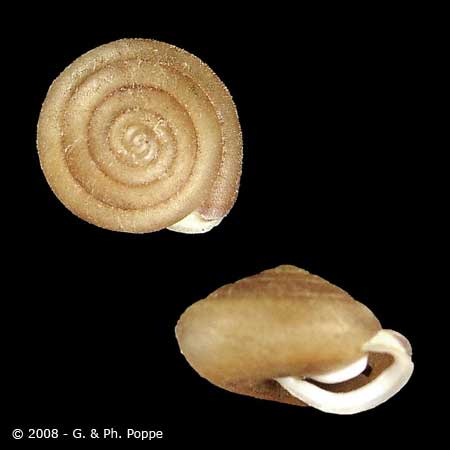Adaptations
There are several adaptations by terrestrial snails like the Upland Pillsnail in order to live their interesting lifestyle:
*Nutrition: The Upland Pillsnail is an herbivore that uses
its radula, a chitinous-teethed
ribbon-like structure, to obtain food such as tree
sap, fungi, lichens, and vegetation
(Hickman, et al., 2007;
Dourson 2006).
 The
radula
is helpful for penetrating the cuticle of leaves
(Willmer 2005).
The
radula
is helpful for penetrating the cuticle of leaves
(Willmer 2005).
*The Upland Pillsnail is a Pulmonate Gastropod Mollusk. These snails have a air-breathing lung, which has adapted from the mantle. The opening of the lung to the outside of the shell, the pneumostome, is near to the openings for the nephridiopore (from the nephridium, or kidney-like excretory organ) and the anus.
*Euchemotrema fraternum also has a well-developed nervous system, like the rest of the Gastropod mollusks, with nerves connecting three pairs of ganglion. They also have statocysts, which are organs used for balance, eyes, chemoreceptors that sense chemical stimuli in the environment, and touch, or tactile, organs (Hickman 2007).
*In order to move about their environment, terrestrial snails continuously lubricate the surfaces they move on with mucus. This use of mucus can be a large contributor to water loss in terrestrial snails. Some species adapt their movement to avoid water loss by covering less surface to go a certain distance. Snails also adapt by living in generally moist environments. Some species must undergo estivation in the hot, dry summer months, where their skin dries out completely, but most terrestrial snails retreat into their shells and cover the entrance with their operculum, or horny, tough plate (Willmer 2005).
*Since the Upland Pillsnail is generally a slow-moving animal, an open-circulatory system is sufficient. This kind of circulatory system is less efficient than the closed type in supplying oxygen to tissues in the body. The open-circulatory system includes a blood vessels, a heart, and blood sinuses (Hickman 2007).
*Terrestrial mollusks also have several adaptations to their kidney/filtration system. They have an "ultra filtration" system to form urine through the fluid supplied. Through this system they can excrete nitrogenous wastes in various climactic conditions (Willmer 2005).
To learn more about the life of the Upland Pillsnail use any of the links on the top of the page!